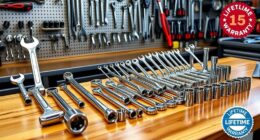Wind turbine blades have serrated edges to boost aerodynamic efficiency and diminish noise. The serrations disrupt turbulent air flow, reducing drag and tonal noise caused by vortices. By enhancing airflow stability and load distribution, they optimize performance. The design minimizes vortices that can lead to vibrations, consequently improving overall aerodynamics. These features contribute to a quieter and more effective wind turbine operation.
Key Takeaways
- Serrated edges disrupt vortex shedding, reducing aerodynamic drag.
- Serrations minimize tonal noise by disrupting turbulent boundary layer scattering.
- Strengthened vortex shedding enhances airflow stability around blades.
- Serrated edges optimize load distribution for aerodynamic stability.
- Trailing-edge serrations improve aerodynamic performance and noise reduction.
Aerodynamic Benefits of Serrated Edges
Introducing serrated edges on wind turbine blades presents significant aerodynamic benefits, revolutionizing their efficiency and noise reduction capabilities. Trailing edge serrations play a pivotal role in enhancing the aerodynamic performance of wind turbine blades by disrupting the formation of vortices. These serrations effectively reduce aerodynamic drag, leading to improved overall efficiency in power generation.
Additionally, the inhibiting effect of serrated edges on tonal noise caused by turbulent boundary layer scattering results in a quieter operation of wind turbines.
Experimental tests have further highlighted the positive impact of serrated edges on vortex shedding. By strengthening vortex shedding gradually, these serrations contribute to a more stable airflow around the blades, ultimately enhancing their aerodynamic performance.
Importantly, the design of serrated edges guarantees that trailing-edge noise is minimized without compromising the load distribution on the blades, maintaining aerodynamic stability throughout operation. Theoretical evidence solidly supports the notion that serrated edges improve power production by reducing drag and optimizing the airflow dynamics around wind turbine blades.
Noise Reduction Mechanism

Serrated edges on wind turbine blades effectively reduce noise by disrupting turbulent boundary layer scattering and inhibiting vortex structure formation on the suction side. The trailing-edge serrations play an essential role in enhancing aerodynamic performance and reducing tonal noise. This noise reduction mechanism is particularly advantageous at larger angles of attack, where the serrations further enhance their effectiveness.
To illustrate the impact of trailing-edge serrations on noise reduction, consider the following table:
| Aspect | Description |
|---|---|
| Noise Reduction | Disrupts turbulent boundary layer scattering |
| Inhibits vortex structure formation on the suction side | |
| Aerodynamic Performance | Improves power production |
| Enhances aerodynamic efficiency | |
| Vortex Shedding | Gradually strengthens vortex shedding |
Impact on Vortex Shedding

Serrated edges on wind turbine blades play a vital role in disrupting vortex shedding, ultimately improving aerodynamic performance. By reducing tonal noise and strengthening vortex shedding gradually, these serrated edges enhance the overall efficiency of wind turbines, especially at larger angles of attack.
Experimental tests have validated the significant positive impact of serrated edges in minimizing vortex shedding-induced vibrations and optimizing airfoil aerodynamic properties.
Vortex Shedding Reduction
Enhancing wind turbine blade design with serrated edges has a notable impact on the reduction of vortex shedding, influencing aerodynamic performance and tonal noise generation. Serrated edges disrupt vortex shedding, reducing harmonic oscillation of vortices and inhibiting the formation of vortex structures on the suction side, which leads to a decrease in tonal noise.
The serrated trailing-edge design also promotes a gradual strengthening of vortex shedding patterns, contributing to improved aerodynamic performance.
- Serrated edges disrupt vortex shedding, reducing harmonic oscillation of vortices.
- Inhibiting vortex structure formation on the suction side minimizes tonal noise.
- The serrated trailing-edge design leads to a gradual strengthening of vortex shedding patterns.
Aerodynamic Performance Enhancement
Improving wind turbine blade aerodynamic performance through the use of serrated edges has a significant impact on reducing vortex shedding-induced vibrations. These serrations play a pivotal role in minimizing the harmonic oscillation of vortices, thereby preventing resonance in the wing structure and enhancing overall stability.
By decreasing the occurrence of vortex shedding, the serrated edges help mitigate flutter issues, contributing to improved flight safety. The design of serrated trailing edges on wind turbine blades is specifically aimed at enhancing flow control and effectively managing vortices.
Significantly, the implementation of serrated edges results in superior aerodynamic efficiency, decreased drag at high velocities, and a heightened lift-to-drag ratio when compared to conventional blade designs. This strategic integration of serrations into wind turbine blades optimizes their performance, ensuring smoother airflow and reducing the detrimental effects of vortex shedding on the wing structure.
Experimental Validation Through Testing

You should focus on testing serrated edge performance to assess their impact on aerodynamics.
Evaluating how these edges affect aerodynamic properties is essential for understanding their noise reduction capabilities.
Testing will help confirm whether serrations truly enhance wind turbine blade performance.
Testing Serrated Edge Performance
Testing the performance of serrated edges through experimental validation has provided significant insights into their impact on wind turbine blade aerodynamics. Here are some key findings from experimental studies:
- Experimental tests have confirmed the positive effect of serrated edges on the aerodynamic properties of wind turbine blades, showcasing improved efficiency and power production.
- Serrations on the trailing edge of blades have been shown to disrupt vortex formation on the suction side, leading to a reduction in tonal noise and enhancing acoustic performance.
- The versatility of serrated trailing edges is highlighted by their more effective tonal noise reduction at larger angles of attack, demonstrating their adaptability in various wind conditions.
These experimental validations not only support the theoretical benefits of serrated edges but also provide practical evidence of their significant impact on wind turbine performance.
Aerodynamic Impact Assessment
Building on the experimental validations that have shown the positive impact of notched edges on wind turbine aerodynamics, the aerodynamic impact assessment through testing further solidifies the effectiveness of these design modifications.
Notched edges play a vital role in tonal noise reduction by inhibiting vortex structures on the suction side of airfoils. This decrease in tonal noise contributes to enhancing wind turbine efficiency. The experimental tests have shown that the notched trailing-edge design promotes a gradual strengthening of vortex shedding, ultimately improving aerodynamic performance.
Furthermore, these notched edges have been proven to be more efficient at reducing tonal noise at larger angles of attack, highlighting their importance in optimizing wind turbine efficiency. By enhancing aerodynamic performance and reducing tonal noise, the integration of notched edges in wind turbine blade design demonstrates a promising pathway towards maximizing wind energy production.
Trailing-Edge Serrations and Power Production

Trailing-edge serrations on wind turbine blades have proven to enhance power production by improving aerodynamic efficiency. These serrations play an essential role in optimizing wind turbine performance.
Here's why they're pivotal:
- Tonal Noise Reduction: The serrations inhibit the formation of vortex structures, leading to a reduction in tonal noise emitted by wind turbines.
- Improved Aerodynamic Performance: Serrated edges attached to the trailing edge enhance the overall aerodynamic performance of wind turbine airfoils.
- Enhanced Wind Turbine Power Production: Serrations have a positive impact on power production by increasing aerodynamic efficiency. Experimental tests and theoretical evidence support this significant impact on boosting the power output of wind turbines.
Wind Tunnel Facility Insights

Wind tunnel testing at TU Delft provides valuable insights into the impact of serrated edges on wind turbine airfoils for optimizing performance. The wind tunnel facility features a 1.80m wide, 1.25m high, and 2.60m long test section, allowing for detailed experimental validation of airfoil designs.
By employing both experimental and numerical methods, researchers can analyze the aerodynamic enhancements resulting from serrated edges. The wind tunnel maintains free-stream turbulence levels ranging from 0.02% to 0.07%, ensuring accurate testing conditions that mimic real-world scenarios.
Through testing in the wind tunnel, researchers can specifically focus on how serrated edges influence wind turbine noise levels. This analysis is vital for developing quieter wind turbines that are more environmentally friendly.
Additionally, the facility helps in studying the aerodynamic properties of airfoils with serrated edges, leading to optimizations that enhance overall wind turbine performance. The insights gained from wind tunnel testing play an essential role in advancing the design and efficiency of wind turbines.
Materials and Application Considerations

When selecting materials for serrated edges on wind turbine blades, consider their durability and compliance with industry standards for best performance. It's essential to choose materials that can withstand the harsh conditions of wind turbine operation while also meeting the specific requirements for aerodynamic efficiency and noise reduction.
Materials Testing: Ensure that the materials used for serrated edges undergo thorough testing to verify their suitability for wind turbine applications.
Compliance with Industry Standards: Select materials that meet the necessary industry standards to guarantee peak performance and longevity of the wind turbine blades.
Aerodynamic Performance: Choose materials that contribute to improved aerodynamic performance when serrated edges are applied, enhancing the overall effectiveness of the wind turbine.
Frequently Asked Questions
Why Do Wind Turbine Blades Have Spikes?
Wind turbine blades have spikes to reduce noise emissions by scattering pressure fluctuations effectively. This decreases sound radiation, meeting noise regulations. Serrated edges can lower noise levels by up to 3dB, enhancing operational efficiency and aerodynamic performance.
Why Do Wind Turbine Blades Have a Twisted Shape?
To optimize aerodynamic performance, wind turbine blades have a twisted shape. This design evenly distributes lift, maximizes energy capture, reduces drag, and adjusts angles along the blade span. It guarantees effective operation in varying wind conditions.
Why Are Wind Turbine Blades so Skinny?
Wind turbine blades are skinny to reduce weight, increase efficiency, and capture more wind energy. They can be longer, sweep a larger area, and minimize material costs. The slender design with serrated edges reduces noise and enhances aerodynamic performance.
Why Are Wind Turbine Blades Tapered?
To understand why wind turbine blades are tapered, picture a bird's wing. Tapering helps control airflow, boosting efficiency, reducing turbulence, and enhancing structural strength. The design optimizes energy capture and minimizes noise, improving power production.
How Do Serrated Edges on Wind Turbine Blades Affect Performance Compared to More Blades?
Wind turbine blade upgrades, such as serrated edges, can affect performance compared to more blades by increasing the efficiency of the turbine. Serrated edges reduce drag and noise, resulting in higher energy output. While adding more blades can provide increased power generation, serrated edges offer a more cost-effective solution.
Conclusion
So, next time you see those serrated edges on wind turbine blades, remember they're not just for show. Those little notches are actually helping to improve aerodynamics, reduce noise, and increase power production.
Who knew a simple design feature could have such a big impact? Keep an eye out for those sneaky serrations – they're doing more than you think!









